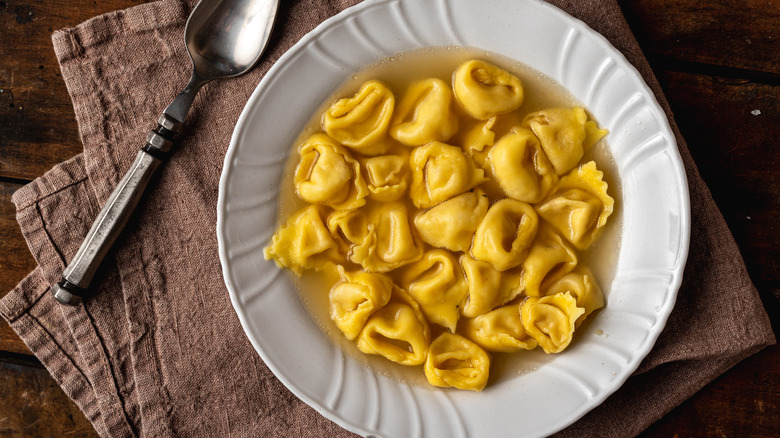How To Tell If Stuffed Pastas Are Cooked Through
Stuffed pasta is a great ingredient to use when you want to up your pasta game. There are all kinds of stuffed Italian pasta according to MasterClass, including tortellini, tortelloni, ravioli, agnolotti, and cappelletti. Then there are perogies, or pierogi, which is a larger stuffed pasta filled with everything from potato to cheese, per James Beard Foundation. These kinds of pasta are delicious when served in a classic red sauce or mixed with a creamy Alfredo sauce, and they can be enjoyed simply served with some melted butter, herbs, and Parmesan cheese.
But while cooking and testing unstuffed pasta such as Gemelli or spaghetti is pretty straightforward (per BBC goodfood), cooking stuffed pasta can be a bit tricky. How can you tell if its cooked through? The filling and the shape of stuffed pasta make the process more complicated. If these kinds of pasta are overcooked they can burst or fall apart, spilling out all that luscious filling. And if they are undercooked, the filling won't be hot enough and the pasta can be tough and stick to your teeth.
How to test stuffed pastas
There is a perfect doneness to pasta called al dente, which means "to the tooth." The pasta will be tender without a raw floury taste, but there is a tiny bit of resistance in the middle that you can feel with your teeth.
Wheat pasta contains protein and starch, held together when the flour is mixed with liquid to make the dough, which is formed into the desired shape. Most pasta is cooked in a lot of boiling salted water. The pasta simmers until the starches in each piece absorb water, a process called gelatinization (per Exploratorium) where the protein denatures or unfolds and the pasta becomes tender.
How you cook stuffed pasta depends on its state: Fresh, dried, or frozen (per Recipe Tips). The fresh and dried types aren't precooked, but frozen stuffed pasta usually is, so you're just reheating it. The only way to tell what you have is to read the label.
Just as you'd cook regular pasta, boil water and add the stuffed pasta to it. Note — frozen stuffed pasta doesn't need to be thawed before cooking it. Set your timer to a few minutes less than the package instructions, then watch the pot. When stuffed pasta is done, it floats to the surface, says Williams-Sonoma, and that's when you need to taste one to make sure the filling is hot and the pasta tender.
Enjoy your perfectly cooked stuffed pasta
Now that you know how to cook pasta to the perfect doneness, let's get into the kitchen. Most people buy stuffed pasta already made, but you can certainly whip up your own. Just be aware that fresh pasta, even stuffed fresh pasta, cooks in just a few minutes. If you want to try your hand at pasta making, this recipe for tortellini from Alton Brown of Food Network would be delicious. Homemade ravioli with sage and butter is a great recipe to test out on a rainy day.
You can also stuff premade pasta shells. It's not quite the same thing, but still delicious. You bake stuffed jumbo shells (they are tested by sticking a fork into a shell to see if it's tender). Or for a quick and easy meal, cook some frozen tortellini you get from your supermarket to tender perfection, and toss it with your favorite heated pasta sauce. Add some Parmesan cheese and dig in.


